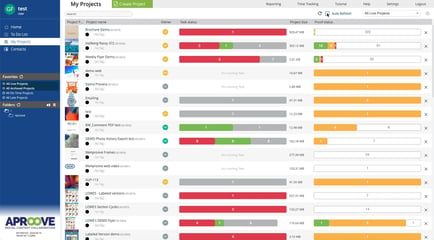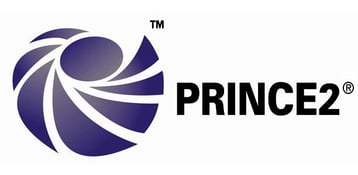Share this
What Is a Project Management Framework?
by Erin Esterberg on August 17, 2021 7:16:33 AM EDT
Managing and executing projects can be challenging. According to research by KPMG, 70% of surveyed organizations have suffered project failures for one reason or another.
 There are various reasons these projects can’t meet their requirements: team productivity issues causing missed deadlines, task dependency, failure in management, change in the organization’s priorities, and others.
There are various reasons these projects can’t meet their requirements: team productivity issues causing missed deadlines, task dependency, failure in management, change in the organization’s priorities, and others.
Nevertheless, most projects fail not due to lack of effort but more often due to the lack of clear direction.
Efforts in the wrong direction are essentially meaningless. This is where the project management framework comes in to provide a more precise approach to your project management efforts.
Project management frameworks essentially provide precise requirements and goals to the project, ensuring:
-
Projects are finished on time within their deadlines
-
Projects staying within their scopes, and
-
Projects staying within budget
This guide will discuss the concept of the project management framework and how you can implement it to help you manage and execute a successful project.
What Is Project Management Framework?
We can think of a project management framework as a set of tools, processes, and tasks that are standardized to take the project from start to finish.
A project management software provides structure, and especially direction, to a project. It includes all the core elements needed for planning, managing, and executing projects to ensure their success.
Project Management Framework VS Project Management Methodology
The terms project management framework and methodology are often used interchangeably, but they are not the same.
While they are indeed closely related, there are also crucial differences to consider between the two.
The main difference is that methodology is about high-level strategies and ideas on planning, governing, and executing a project. On the other hand, a framework is considered the derivative of methodology, outlining the step-by-step processes required to manage and execute different projects.
To use an analogy, we can say that a methodology tells us the principles of writing a book and the criteria of a good book.
A framework offers an actual step-by-step guide on how to write the book according to the methodology.
Project Management Framework: Three Core Elements
 Now that we’ve understood the concept of the project management framework, here we will learn how to create one.
Now that we’ve understood the concept of the project management framework, here we will learn how to create one.
It’s important to note that although there are different project management framework techniques we can use, all of them will always involve the three core elements:
-
Project life cycle
-
Project artifacts
-
Tools
Let us discuss them one by one.
Project Life Cycle
The project control cycle refers to the cycle a project must go through from start to its completion, which involves five life cycle processes:
-
-
Initiation: where we define what the project is about. Figuring out objectives, identify the project’s requirements for success, identify potential risks, and decide whether the project is attainable.
-
Planning: listing all the tasks and steps required to execute the project in a detailed roadmap. Identifying teams, assigning roles and responsibilities, estimate each task’s timeline, and create comprehensive schedules
-
Execution: the actual execution of the project. Ensuring team members stay on schedule and finish their tasks.
-
Monitoring: monitoring the execution of the project to make sure you are on the right track. Creating reports, adjusting strategies and priorities when necessary according to internal changes and/or market shifts.
-
Closure: wrapping up the project, evaluating the results when all the tasks get completed before scheduling any updates or revisions when required.
-
While different project frameworks might involve different guidelines to structure each of these life cycle processes, they will always include these five.
Project Artifacts
This refers to the output of the framework to help the process of controlling and monitoring the project.
In practice, the project management framework offers specific outputs generated using guidelines or templates, which will help us in monitoring the project throughout its different life cycle phases (as discussed above)
Various types of project management artifacts will apply to different situations; some examples are:
-
Strategy artifacts: documentation that relates to the overall strategy of the project, like project charter, roadmap, business case, and vision statement
-
Logs: various logs and registers of the project management like product backlog, assumption log, risk register, etc.
-
Plans: Any plans created to execute the project, such as the scope management plan, logistics plan, quality control plan, etc.
-
Hierarchy charts: charts describing relationships between different elements of the project like work breakdown structure, product breakdown structure, and organizational breakdown structure
-
Reports: project management tends to involve many reports, including but not limited to quality reports, status reports, risk reports, and others
-
Baselines: approved versions of plans like budget baseline, performance measurement baseline, milestone schedule, etc.
-
Contracts: various agreements and contracts like MOU, time and materials contract, and any other type of legally binding contracts and agreements
Tools
The third element of the project management framework is visualization tools to help you monitor and control the status of your project.
There are various tools we can use here, but the most popular ones are:
-
Gantt chart: is undoubtedly the most popular chart in project management. The Gantt chart offers a timeline view of your projects, allowing you to visualize how different project tasks get executed within the overall timeline and how these tasks connect.
-
PERT chart: another popular chart commonly used for scheduling. PERT stands for Program Evaluation and Review Technique, and the chart uses a network diagram to visualize the activities and milestones of the project.
-
Burndown chart: the burndown chart compares the rate of completed tasks to your initial plan/schedule, as well as the time left until the deadline. Very useful for time management.
-
Control chart: helpful in monitoring a specific process in the project, control charts offer a reliable way to monitor the stability of a process, typically in the form of a graph with upper control limit, lower control limit, and a baseline (average process output).
-
Critical path chart: is a flowchart used to visualize the project's critical path (critical path method CPM). CPM Allows you to estimate the overall duration of the project.
Besides the visualization tools, various solutions like workflow management software, project scheduling tool, and others can be considered as parts of this element.
Why Is Project Management Framework Important?
Applying a framework in your project management enables your project managers and team to understand and implement the best practices to each scenario throughout the project’s planning and execution.
When a project management framework is in place, the project team will be more effective and efficient in handling changes and unexpected situations.
As a result, this will provide the following benefits:
-
Ensuring consistent processes across the entire project execution. That consistency will translate to accuracy, allowing projects to be completed on time and within budget.
-
Project management workflow essentially breaks down the project into smaller tasks. This simplifies the project’s execution and monitoring, allowing project managers to assign roles and responsibilities more effectively to the right people.
-
Better clarity. The framework visualizes all tasks and steps necessary to complete the project and the tools required to complete each task. This will prevent confusion and disputes throughout the project execution.
-
Allowing project managers and business owners to identify inefficiencies and bottlenecks. This can help managers to determine how much time and money is spent on the project. Ultimately, the project can be optimized to be more efficient and cost-effective.
-
Improving transparency and accountability of all team members and stakeholders, which in turn will boost the team’s productivity in executing the project.
-
Better collaboration and communication. With the implemented project management framework, project managers can be more effective in communicating everything related to the project. At the same time, team members can more effectively communicate their tasks and responsibilities with each other.
How To Choose a Project Management Framework
As discussed, there are various frameworks you can choose from, and it’s crucial to understand that there is no one-size-fits-all framework that will suit all projects. This is why so many frameworks have been and are still being developed today.
Choosing your project management framework should be situational, depending on the project itself and various factors.
We will discuss some of the most popular frameworks and their implementations further below, but here are some key considerations you should have when choosing your framework:
-
You can choose frameworks based on familiarity, for example, using the frameworks your stakeholders have used in the past. Familiarity will help with implementation, but check whether the framework is suitable for your specific project based on the other rules below.
-
Assess whether the project’s deliverable is tangible or intangible. If the deliverable’s requirements aren’t well defined, you should choose a print-based framework (i.e., Scrum)
-
For tangible products and stable industry, select a framework that allows you to plan the project in a detailed and structured way like Waterfall or Prince2
-
For fast-changing sectors or products, choose adaptable frameworks like Scrum, SAFe or XPM
-
If waste management is an essential priority for your project, then you should select a lean framework
However, keep in mind that framework implementation should be flexible. You can mix and match different elements from different frameworks depending on the project’s needs or even change to another framework midway as your project changes.
Different Types of Project Management Frameworks
Above, we have mentioned some framework names you might not be familiar with. Different projects, teams, and organizations have their unique needs, and this is why there are so many unique workflows available; each is designed to suit unique projects and use cases.
With so many project frameworks variations, we obviously can’t discuss them one by one in this guide. However, we will discuss some of the most popular ones and how they’ll fit in a project.
CCPM
CCPM stands for Critical Chain Project Management, and it focuses on building a project schedule that emphasized a “critical chain” of tasks, the tasks that will matter the most to the project’s success. The goal of this framework is to reserve the available resources for this critical chain, so the timeline of the project might be longer, but we can maintain accuracy and reliability.
Great for: projects with identifiable critical tasks and where deadlines aren’t very tight
Not great for: projects with short deadlines since CCPM will typically allow extra time buffers along with the critical chain
Not great for: projects with short deadlines since CCPM will typically allow extra time buffers along with the critical chain
SAFe
SAFe stands for Scaled Agile Framework, and as the name suggests, it is an agile-focused framework that also facilitates scalability. Most agile frameworks (i.e., Scrum) are performed by dividing the team into smaller teams, but this might not be ideal in substantial projects where we might need to have hundreds of smaller teams.
SAFe provides structure to managing these multiple smaller teams and managing the relationships between these teams. This is achieved mainly via high-level program backlogs and release planning.
Great for: large companies that want to use agile frameworks without giving up high-level control
Not great for: smaller companies that can use traditional agile frameworks since they will typically perform better
Scrum
Scrum is one of the most popular agile frameworks available today and is performed by breaking down the deliverable (final product of the project) into smaller chunks. This is why Scrum is ideal for software products, but it can be applied to any project with multiple stages.
These smaller chunks are prioritized and executed in a series of sprints, a period of fewer than four weeks (typically one or two weeks) where the team will focus on finishing this task. At the end of each sprint, the product increment is presented.
Scrum is also famous for breaking down the team into small and flexible teams (5-11 people), and this smaller team is responsible for delivering a product increment with every sprint.
Great for: complex projects that feature unpredictable changes, especially in a fast-moving industry
Not great for: projects where the final product cannot be broken down into increments. Also, hard to apply in substantial projects
PRINCE2
 PRINCE2 stands for Projects in Controlled Environments and is a prevalent project management framework used by various teams worldwide.
PRINCE2 stands for Projects in Controlled Environments and is a prevalent project management framework used by various teams worldwide.
PRINCE2 is a process-based approach, focusing on management and control of the entire project rather than agility. We can say that this framework focuses more on accuracy than speed. Roles and responsibilities are clearly defined, and teams should constantly focus on the quality of the deliverables.
Great for: projects where accuracy is critical, for example, when the deliverable must comply with specific regulations.
Not great for: projects that demand agility and speed
Lean
The lean project management framework focuses on minimizing wasted resources and eliminating redundancies. Basically lean project management framework applies lean manufacturing principles to project management. Lean manufacturing principles were developed by Toyota in the 1950s and focuses on eliminating three types of waste: muda, muri, and mura, the 3M.
-
Muda is the activities that consume resources without producing additional value
-
Muri is the overuse of employees and/or equipment
-
Mura is inconsistencies (unevenness) in operations, which reduces productivity and efficiency in the long run
The lean project management framework essentially aims to reduce the 3M during the project execution.
Great for: projects where efficiency and waste management are the main concerns
Not great for: projects where the 3M is hard to identify and/or changes constantly
Waterfall
One of the classic frameworks but is still widely used in many projects and organizations.
It can be considered the most basic way to manage a project and the simplest to implement. In this framework, the project is mapped into sequential phases, with each new phase beginning only when the previous one has been completed (just like a waterfall).
In the waterfall framework, changes are often not allowed to consider it a very rigid framework. However, it is arguably the best framework for long projects that require only a single timeline.
Great for: long projects with a lot of steps/tasks in between
Not great for: projects with a lot of unexpected changes and/or overlapping work by multiple teams
Closing Thoughts
The project management frameworks are there to help you structure how you’re going to
manage and execute your projects rather than building something from scratch. There are various templates of project frameworks available, so you can use them right away to plan and manage your project.
It’s crucial to choose the proper framework according to your project’s requirements, timeline, industry, and team capabilities, among other factors. The appropriate framework can help your team collaborate better when executing the project, guiding the project to successful results.
Share this
- Project Management (25)
- Featured (24)
- Business Workflow (22)
- Educational (22)
- New Release (22)
- Online Proofing (22)
- Work Management (22)
- Workflow Management (22)
- BPM Software (17)
- Business Automation (16)
- Marketing management (16)
- Newsletter (16)
- Workflow Automation (11)
- Marketing Workflow (10)
- BPM (9)
- Marketing Automation (8)
- Digital Asset Management (6)
- News (6)
- Industry News (4)
- Task Management (4)
- business process workflow (3)
- enterprise project management (2)
- insurance work management (2)
- marketing process (2)
- AI (1)
- Aproove news (1)
- Case Studies (1)
- Case Study (1)
- DAM Software (1)
- Document Management Automation (1)
- Document Workflow Automation (1)
- Insider (1)
- Marketing Agency (1)
- Retail Marketing (1)
- workflow process mapping (1)
- October 2024 (4)
- September 2024 (8)
- August 2024 (10)
- July 2024 (9)
- June 2024 (11)
- May 2024 (6)
- April 2024 (7)
- March 2024 (7)
- February 2024 (6)
- January 2024 (4)
- December 2023 (3)
- November 2023 (7)
- October 2023 (7)
- September 2023 (3)
- August 2023 (5)
- July 2023 (3)
- June 2023 (1)
- May 2023 (1)
- April 2023 (1)
- February 2023 (2)
- September 2022 (3)
- August 2022 (1)
- July 2022 (1)
- May 2022 (1)
- March 2022 (3)
- February 2022 (3)
- January 2022 (3)
- November 2021 (2)
- October 2021 (2)
- September 2021 (1)
- August 2021 (4)
- July 2021 (4)
- June 2021 (2)
- May 2021 (3)
- April 2021 (1)
- February 2021 (1)
- November 2020 (1)
- October 2020 (2)
- July 2020 (4)
- June 2020 (2)
- May 2020 (2)
No Comments Yet
Let us know what you think